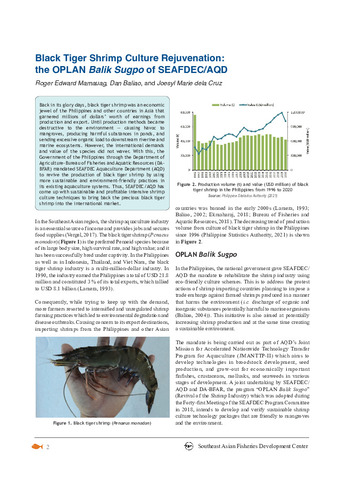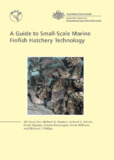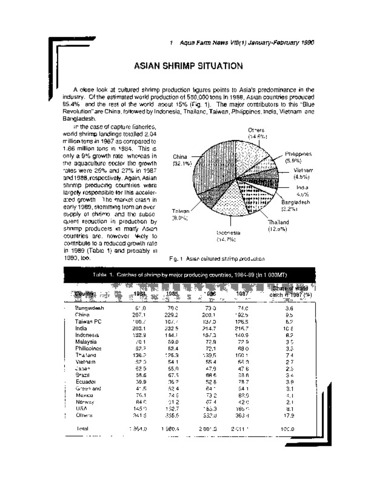Black tiger shrimp culture rejuvenation: the OPLAN Balik Sugpo of SEAFDEC/AQD

ရက်စွဲ
2021Page views
881
Share
စိတ္တဇ
Back in its glory days, black tiger shrimp was an economic jewel of the Philippines and other countries in Asia that garnered millions of dollars’ worth of earnings from production and export. Until production methods became destructive to the environment — causing havoc to mangroves, producing harmful substances in ponds, and sending excessive organic load to downstream riverine and marine ecosystems. However, the international demands and value of the species did not waver. With this, the Government of the Philippines through the Department of Agriculture-Bureau of Fisheries and Aquatic Resources (DABFAR) mandated SEAFDEC Aquaculture Department (AQD) to revive the production of black tiger shrimp by using more sustainable and environment-friendly practices in its existing aquaculture systems. Thus, SEAFDEC/AQD has come up with sustainable and profitable intensive shrimp culture techniques to bring back the precious black tiger shrimp into the international market.
Suggested Citation
Mamauag, R. E., Baliao, D., & Cruz, J. M. d. (2021). Black tiger shrimp culture rejuvenation: the OPLAN Balik Sugpo of SEAFDEC/AQD. Fish for the People , 19(2), 2-7. http://hdl.handle.net/20.500.12066/6694
ဘာသာရပ်
စုစည်းမှုများ စုစည်းမှုများ
Related items
Showing items related by title, author, creator and subject.
-
A guide to small-scale marine finfish hatchery technology
Sim, Sih-Yang; Rimmer, Michael A.; Toledo, Joebert D.; Sugama, Ketut; Rumengan, Inneke; Williams, Kevin; Phillips, Michael J. (Network of Aquaculture Centres in Asia-Pacific, 2005)Recent improvements in hatchery production technology for high-value marine finfish species such as groupers have led to an increased interest in setting up hatcheries to produce fingerlings for aquaculture. Small-scale ... -
A further note to “fishing gear for prawn and shrimp used in the Philippines today”
Motoh, Hiroshi (Carcinological Society of Japan, 1983)Motoh (1980) reported 9 and 13 kinds of shrimping gear for the fry and the adult respectively, of which most of them are indigenously used today in the Philippines. Howerver, druing the continued ecological survey of ... -
Asian shrimp situation
Carreon-Lagoc, Julia; Southeast Asian Fisheries Development Center, Aquaculture Department (Aquaculture Department, Southeast Asian Fisheries Development Center, 1990)




